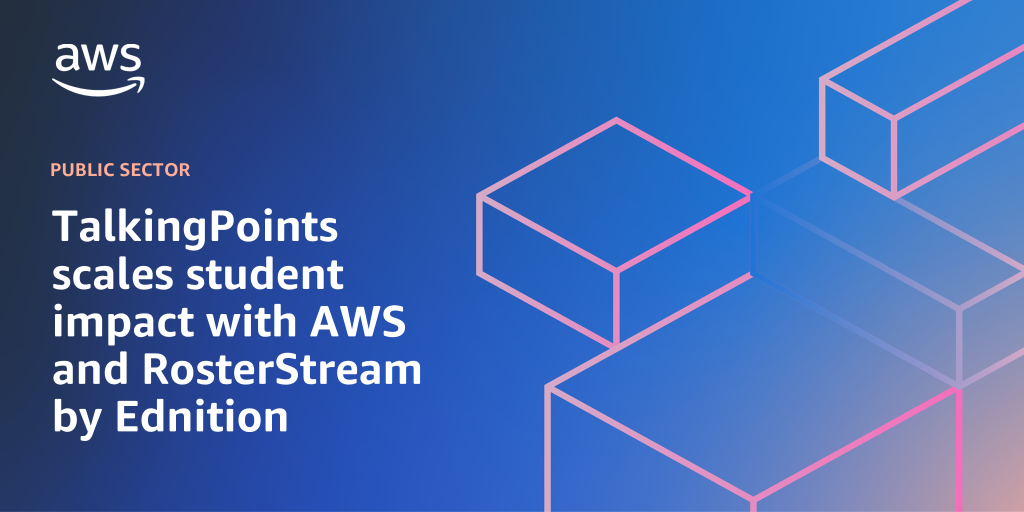AWS Public Sector Blog
Tag: Amazon Kinesis
TalkingPoints scales student impact with AWS and RosterStream by Ednition
In this post, we explore how TalkingPoints partnered with AWS and Ednition to build a real-time, scalable infrastructure that powers more proactive communication between schools and families.
AWS demonstrates resilient and secure edge-to-cloud at Department of Defense exercise
The US Department of Defense (DoD) increasingly relies on commercial efforts to adopt and integrate novel and emerging technologies that are critical for mission success. The modern defense landscape evolves rapidly, and industry collaboration is a key component of success. AWS has risen to the challenge to fulfill this commercial- and collaborative-focused approach to advancing military innovation. Most recently, AWS did so through its participation in the Technology Readiness Experimentation (T-REX) series of events with partner General Dynamics Information Technology (GDIT),
Strengthen federal space resilience with AWS Ground Station
In this post, we explore how AWS Ground Station public sector organizations with on-demand access to AWS-managed antennas that are available as shared or dedicated resources, scaling to the unique requirements of the mission. By adding resource capacity and redundancy with AWS-managed antenna systems, government customers can rapidly increase, differentiate, and distribute their ground segment capabilities. This enables a more flexible and resilient space architecture that can dynamically adapt to changing mission demands.
Near real-time dashboards from a source database to a cloud data warehouse on AWS
Organizations require solutions for real time or near real time dashboards that can be provided to their customers without impacting their database performance or service level agreements (SLAs) to their end users. In this post, we showcase the integration of Amazon Web Services (AWS) capabilities to present an end-to-end architecture for this data flow.
Building belonging in digital student communities with AI on AWS
In today’s rapidly evolving educational landscape, fostering a sense of belonging and engagement is crucial to student success and retention. An August 2024 report by the Institute for Higher Education Policy found that attending to students’ experience and degree of belonging improves academic performance and retention, especially for first-year students from historically underrepresented groups in […]
UNSW students build an all-electric race car with AWS
In 2023, the students from Redback Racing at the University of New South Wales (UNSW) wove together their many disciplines of engineering prowess to create their latest cars: RB23 and RB21-D. After developing and going live with their real-time telemetry system on Amazon Web Services (AWS), the team has placed as the highest-ranking Australian squad in the electric vehicle (EV) division of the Australasia Formula SAE competition, placing second overall. Read this post to learn more.
University Hospitals Coventry and Warwickshire NHS Trust digitizes and improves patient experience with AWS
Like many healthcare providers, University Hospitals Coventry and Warwickshire (UHCW) NHS Trust, which manages two major hospitals and serves a population of more than one million, has operated with legacy technology that relies heavily on phone calls and manual processes for contacting patients. Recognizing an opportunity to modernize, the Trust linked up with IBM Consulting for an innovative pilot project to digitize patient engagement channels using Amazon Web Services (AWS). Read this post to learn more.
Safeguarding data exchange in government using AWS
When government agencies choose Amazon Web Service (AWS) to store data, they choose to take advantage of inheriting the strictest security controls and standards. In addition, AWS services offer a unique opportunity to enhance networking and security approaches, ensuring safe and resilient data transfer mechanisms. This blog post provides guidance towards data sharing among government agencies, offering prescriptive approaches and best practices for implementing secure data exchange solutions using AWS services.
The role AWS is playing in Prosper Africa Tech initiatives
The Prosper Africa Tech for Trade Alliance is a collaboration uniting leading American and African tech companies behind the mission of accelerating e-commerce and digital trade in Africa. The recently announced collaboration between Amazon Web Services (AWS) and Choppies, a leading supermarket chain in Botswana, exemplifies the Alliance’s model of impact-oriented public-private partnerships. This post highlights the AWS-powered deployment of Choppies’ state-of-the-art Farmer’s app across its supplier network.
Improving customer experience for the public sector using AWS services
Citizens are increasingly expecting government to provide modern digital experiences for conducting online transactions. Market research tells us 63 percent of consumers see personalization as the standard level of service. This post offers various architectural patterns for improving customer experience for the public sector for a wide range of use cases. The aim of the post is to help public sector organizations create customer experience solutions on the Amazon Web Services (AWS) Cloud using AWS artificial intelligence (AI) services and AWS purpose-built data analytics services.









